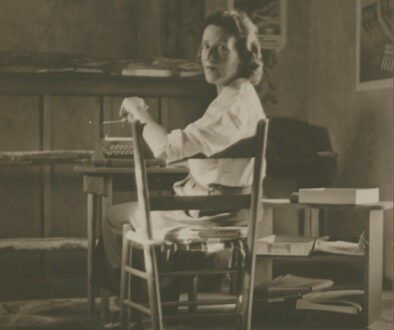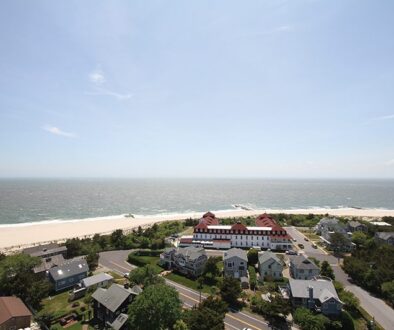A Rare Vintage
When Ed Wuerker takes flight, everyone in the neighborhood knows it.
Wuerker is the proud owner of a TBM Avenger, one of the most famous fighter planes of World War II. The mighty warbird has a gross weight of more than five tons, and boasts a turbo-charged Wright Cyclone engine. When it’s cranked for takeoff, the roar can be heard for miles around.
“I don’t even tell my wife most days when I get ready to fly—she can hear it,” says Wuerker, who lives in Rio Grande, a short distance from Cape May County Airport. “Each stack is over 900 horsepower, and there’s no muffler. So when it barks, it’s quite loud.”
The vintage planes are sometimes called “turkeys,” and the shoe fits. Avengers are bulky and utilitarian, with a wing span almost equal to their length. They’re a far cry from the light, sleek dive bombers—Corsairs, Mustangs and Lightnings—that took the lead in aerial dogfights.
The Big Guns
But Avengers, with room for 2,200 pounds of bombs, were also built for action. And they saw it—at the epic Battle of Midway, and in every major air-sea battle of the war, including Guadalcanal, the Battle of the Philippine Sea, and the Battle of Leyte Gulf, the largest naval battle in modern history. There, in a pivotal victory for the Allies, Avenger torpedoes helped sink Japan’s two largest battleships. (In a historic footnote, a young aviator piloting an Avenger was shot down in the Pacific in 1944. Though his crew members died, George H.W. Bush managed to release his payload before bailing out. He went on to win the Distinguished Flying Cross—and later, the presidency.)
Because Wuerker’s plane was one of the last to roll off the GM assembly line in Trenton in 1945, it never saw combat. “The war was winding down,” he says. “It was assigned to a squadron in California and put on surplus, then put to use as a fire bomber for the Forest Protection Unit.” Other Avengers in the original fleet of 10,000 also were retrofitted with water tanks inside the bomb bays. “That saved their lives,” says Wuerker. “There probably wouldn’t be any left if not for that.”
Today, about 70 of the historic crafts remain. Some are in museums; one is hangared inside the Naval Air Station Wildwood Aviation Museum at the county airport. Perhaps 35 Avengers are still flyable, including his, says Wuerker.
As for the others? “Well, you may be cooking your supper on one,” he says with a laugh. “Aluminum frying pans—who knows what they turned into? They were scrapped like thousands of other bombers, just ground up. Then some nostalgic people decided they were chopping up history. And that’s when they started saving them.”
Eyes on the Skies
Wuerker has always loved flying. He grew up on a county farm, and was just a tot in 1941, when the United States entered World War II and the local airport was built. As a child, he would watch with fascination as fighter planes swarmed the site, which was then commissioned as an active dive-bomber squadron training facility.
“I lived right on the other end of the runway, so I always saw the airplanes flying around,” he says. “I was just…‘I want to do that.’”
Though his mother disapproved, Wuerker started flying lessons when he was in high school, and later joined the Civil Air Patrol. He even remembers when he took his first flight: May 28, 1957. The date has double significance: it is also the birthday of Wuerker’s wife, Suzanne. Fittingly, her name, in elegant script, now graces the side of the vintage craft.
“It’s her plane,” Wuerker says. “She just lets me fly it.”
Suzanne Wuerker wasn’t really surprised when her husband decided to buy a World War II plane. “Early on in our marriage he said, ‘I really want to get a P51’”—a Mustang dogfighter, which can sell for millions of dollars. “My jaw dropped, and I got my Irish temper up,” says Suzanne. “Every kid growing up wants one, but it’s not realistic. I said, ‘Don’t even think about it.’”
Then, in 2006, they discovered that a TBM Avenger was for sale in Canada. Comparatively speaking, it was a bargain: just $60,000. “We went together in the camper and saw it,” remembers Suzanne. “When they started it up they said, ‘Stand back and put your fingers in your ears.’ I was glad they forewarned me.”
Among the challenges in flying this craft: the cockpit is not equipped with dual controls. In other words, “You have to read the manual to fly it,” says Wuerker. “There’s no way to get dual-seat training. But if you’re a pilot, you know what you’re looking for and what to do. And the thrill of pushing the throttle forward for the first time in this thing is quite awesome.”
Up, Up and Away
Like the Avenger, Wuerker himself never went to war. He joined the National Guard in 1957, after World War II and the Korean War, and before the United States became deeply involved in Vietnam. “I did my six years when nothing much was happening,” he says. Then he returned full-time to farming, and continued to fly as a private pilot. In addition to the Avenger, he owns a four-seat Cherokee 160. And in the mid-1980s, he even built his own Scorpion helicopter, a project that took several years to complete.
“That was before the home-built craze, before it was chic,” he says. “The first time I brought it out of the barn to fly, I cried. The joy of it is hard to describe—I built the thing. I did the metal tubing and the plates. I cut the steel. And it was flying. I can imagine what people feel when they make these rockets that shoot to the moon. To see this piece of hardware you put your heart and soul in, to see it do what it’s designed for, is a tremendous feeling.”
To this day, Wuerker has a heliport on his property. But when the family farm became Hawk Haven Winery, the helicopter was moved out of the barn to make way for other equipment. It’s now “sitting in the weeds,” says Wuerker. “I haven’t flown it in 20 years.”
He also rarely flies the Avenger, for several reasons: it requires a ground crew to remove the chocks and start the propeller. And as hobbies go, this is an expensive one: the plane consumes 70 gallons of fuel an hour, at $6 a gallon. “I can see the same sights out of my smaller airplane,” says Wuerker, “and for a lot less money.”
Though the Avenger is largely a showpiece, he’s proud to own a piece of history, a plane that helped the Greatest Generation win its war. One member of that generation is Nick Cooney, a 90-year-old veteran who was born in Philadelphia and now lives with his daughter and her husband in Swainton.
Cooney was a turret gunner, who occupied the seat behind the pilot. (A third crew member would sit in the bombardier position, in the belly of the craft). He was barely out of high school when he joined the Navy and volunteered for gunnery and aerial training. In one memorable battle, searching for a Japanese convoy in the China Sea, his Avenger found the fleet before U.S. fighter planes arrived. “We were hung out to dry,” remembers Cooney. “We got a shell in the back of our plane, and our radio man was fatally wounded. His face was blown away. I tried to help him, but he bled to death in just a couple of minutes.”
For his service, from 1943 through 1945, Cooney would earn battle stars for Iwo Jima, Okinawa, the China Sea and the Japanese Homeland, as well as the Distinguished Flying Cross and a Presidential Unit Citation, among other brass. He is also an honorary member of the Battle of the Bulge South Jersey Chapter.
Of the Avenger, he says, “It was one hell of a plane. It could take a beating like no other. One time when we got back we had 108 holes in the thing. Another time we came back with part of our tail shot off, but we were still flying. Anyway, it was super plane. If I had to go again, that would be the plane of my choice.” Even so, asked if he would take a ride with his old friend Ed Wuerker in the Suzanne, Cooney is blunt. “I wouldn’t get in that damn thing,” he says. “It’s 50, 60 years old!”
But Wuerker keeps flying. He couldn’t keep it a secret if he wanted to.
“We know when he’s up there; that plane has a particular sound,” says Dr. Joseph “Doc” Salvatore, founder of the Naval Air Station Wildwood Aviation Museum. “Can you imagine in World War II, there were 300 airplanes here with that sound? Eddie lived right across the street, so he was aware of a lot of that stuff. That’s what got him started.”
“Yes, it’s noisy,” says Wuerker of his vintage plane. “To me, that’s the sound of freedom.”














